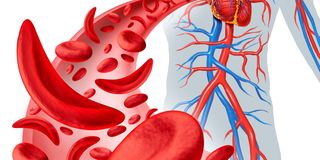Vigilance, action needed to eradicate sickle cell disease

A depiction of sickle-cells. A new form of treatment for sickle cell disease has been approved by a US-based drug’s regulator.
Sub-Saharan Africa (SSA) has the world's highest incidence of sickle cell disease (SCD), with about 240,000 children born with the disease each year.
Unfortunately, most of the deaths for patients with SCD are found in SSA with more than 70 percent of them from preventable causes like infections, lack of access to safe blood and lack of access to disease modifying drugs like hydroxyurea. In Kenya, it is estimated that there are 14,000 new cases of SCD each year. A significant number of children are not diagnosed, unfortunately, because we do not have a newborn screening programme and sickle cell disease registries.
For the children diagnosed with SCD, it is estimated that 50-90 percent of these patients will not celebrate their fifth birthday as a result of lack of appropriate care. Early diagnosis can significantly improve the quality of life for people suffering from SCD through active screening and connecting these patients to appropriate care centres.
There are 17 counties that are considered to have a high burden of SCD. They are mainly in the coastal region, Nyanza, and Western Kenya. Some studies suggest screening of newborns in these areas to help bridge the gap in diagnosis. SCD is a genetic condition that is passed down from parent to child. The sickle cell gene, which is classified as a recessive gene, must be present in both parents for a child to develop the disease. The sickle cell gene protects against malaria, hence the high prevalence of the disease in malaria endemic areas. Parents who can afford it can get genetic tests to see if they are carriers of sickle cell disease, which will better prepare them to deal with the illness if it manifests in their children.
For parents who may not have access to testing, being vigilant for symptoms should be a top priority. The symptoms of SCD are severe and, if left untreated, can quickly lead to serious complications. Anaemia, and /or yellowness of eyes (jaundice) and recurrent body pains are the most common symptoms of the disease. While the pain can occur anywhere in the body, it is most felt in the arms, legs, and chest.
When a sickling crisis occurs in the lungs, it can cause a condition known as acute chest syndrome, which is like pneumonia and is characterised by chest pain, fever, cough and shortness of breath. Some patients may present with other complications of SCD like stroke, splenic sequestration (where blood pools in the spleen) or priapism (prolonged and painful erection in a nonsexual child).
As we commemorate World Sickle Cell Disease Day, we celebrate the progress made in advancing SCD care in Kenya and globally. We seek to advocate for the health of children with SCD through a comprehensive care approach, advocacy and health systems innovation. There is hope for patients with SCD to have healthy and fulfilling life.
Dr Doreen Karimi is a Paediatric Haematology Oncologist at Gertrude's Children's Hospital. [email protected]ily Nation Coast





